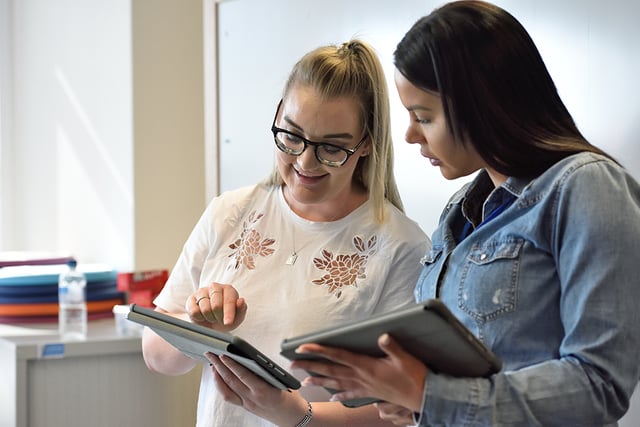How We Used Computational Thinking to Analyze Digital Equity
 Insights By Anna McVeigh-Murphy
Insights By Anna McVeigh-Murphy
We launched an online PD course to empower educators to teach computational thinking in their classrooms. While researching and preparing the materials, we noticed that there weren’t a lot of examples of what a computational thinking process looks like in action.
And educators know that having contextual and real-life examples of learning content is essential for building understanding of that topic.
In this article, we are trying to solve for that by providing a step-by-step look at how we applied computational thinking to analyze the access and connectivity divide as a part of our digital equity whitepaper.
Beginning with a Big Question
We started with the question: Is the access and connectivity divide closed?
This was in response to a Hechinger Report article titled, Nearly all American classrooms can now connect to high-speed internet, effectively closing the “connectivity divide”. And we wanted to know if this was a valid and fair statement.
Step 1: Decomposition
The access and connectivity divide is a broad problem, so to understand it better we broke it down into different questions:
- What are the rates of access in schools?
- What are the rates of connectivity in schools?
- What are the rates of access in homes?
- What are the rates of connectivity in homes?
Our next step then was to gather data for each question, which required extensive research. We’ve captured these finding below.
Question 1: What are the rates of access in schools?
In 1997, the ratio of students to computers was 24:1.
In 2018, over 50 percent of educators report that their school is 1:1; and according to a 2018 study by COSN, 43 percent of Technology Directors said they would be 1:1 within three years.
Question 2: What are the rates of connectivity in schools?
In 1997, only 14 percent of United States classrooms had internet access.
In 2019, 99 percent of all K-12 districts in the United States have high-speed internet for students.
Question 3: What are the rates of access in homes?
Pulling from census research, we were able to track rates of computer ownership in homes from 1984 to 2015.
| Year | Households with a computer |
|---|---|
| 1984 | 8% |
|
1989 |
15% |
| 1993 | 23% |
| 1997 | 37% |
| 2000 | 51% |
| 2001 | 56% |
| 2003 | 62% |
| 2010 | 77% |
| 2011 | 76% |
| 2012 | 79% |
| 2015 | 79% |
Question 4: What are the rates of connectivity in homes?
Pulling from census research, we were able to track rates of broadband connectivity in homes from 1997 to 2015.
| Year | Households with a broadband subscription |
|---|---|
| 1997 | 18% |
| 2000 | 42% |
| 2001 | 50% |
| 2003 | 55% |
| 2010 | 71% |
| 2011 | 72% |
| 2012 | 75% |
| 2015 | 77% |
Step 2: Pattern Recognition
For questions one and two, it’s clear that access and connectivity have surged in schools, effectively closing the connectivity divide and narrowing the access divide significantly.
However, for questions three and four, we plotted the data points on a graph to better conceptualize the more nuanced data points.

In doing so, we found significant growth in the rate of households with a computer from 1984 to 2015 and internet access from 1997 to 2015 as well. However, rates have largely plateaued since.
Step 3: Abstraction
From the patterns we detected, we can quickly abstract that significant progress has been made in terms of narrowing the access and connectivity divides. While this work has made connectivity nearly universal in schools and devices readily available, access and connectivity in homes has largely stagnated leaving more than 20 percent of American families without these modern tools.
Step 3.1: Decomposition again
In looking at the generalized information about the access and connectivity divide, we now had more questions we wanted to address: Who lacks computers and broadband internet? Are there demographics more impacted than others?
These questions took us back to the data gathering phase. Now, we had a more targeted perspective and wanted to break down the data by key demographic groups: race, income bracket, English proficiency, and location.
| Demographic | Household with a computer | Household with a broadband subscription |
|---|---|---|
| White alone, non-Hispanic | 88 | 79.3 |
| Black alone, non-Hispanic | 80.1 | 64.5 |
| Asian alone, non-Hispanic | 94.1 | 88.5 |
| Hispanic (of any race) | 84.2 | 70.5 |
| Less than $25,000 | 67.1 | 51 |
| $25,000-$49,999 | 84.3 | 70.9 |
| $50,000-$99,999 | 93.9 | 85.6 |
| $100,000-$149,999 | 97.6 | 92.9 |
| $150,000 and more | 98.4 | 95.3 |
| Non-English Speaking | 87.6 | 77.7 |
| English Speaking | 70.2 | 55.6 |
| Metropolitan area | 88 | 78.4 |
| Nonmetropolitan area | 80 | 67.2 |
Step 3.2: Pattern Recognition again
Like the previous analysis, we decided to visualize the data by demographic in order to identify any key patterns.
Computer Ownership and Broadband Subscription Rates by Race

Pattern: Compared to black and Hispanic respondents, white and Asian respondents are significantly more likely to have access to internet-connected devices.
Computer Ownership and Broadband Subscription Rates by Income Bracket

Pattern: Compared to all other brackets, the lowest income bracket (less than $25000) and the second lowest bracket ($25000 to $50000) exhibit significant lags in both computer ownership and broadband subscription rates.
Computer Ownership and Broadband Subscription Rates by English Proficiency

Pattern: There is a discrepancy in device ownership and broadband subscription rates between English and non-English speaking households.
Computer Ownership and Broadband Subscription Rates by Location

Pattern: Rural and urban households show gaps in access and connectivity.
Step 3.3 Abstraction again
In order to abstract information from these data sets, we coalesced all the patterns we noted.
- Compared to black and Hispanic respondents, white and Asian respondents are significantly more likely to own a computer and have access to internet-connected devices.
- Compared to all other brackets, the lowest and second lowest income brackets exhibit significant lags in both computer ownership and broadband subscription rates.
- There is a discrepancy in computer ownership and broadband subscription rates between English and non-English speaking households.
- Rural households are less likely to own computers and have internet access than households in urban settings.
Abstraction #2: After reviewing these patterns, our takeaway was this: access and connectivity rates are impeded by longstanding inequities in society that affect minorities, low-income families, non-English speaking households, and those residing in rural areas.
Abstraction #1: This abstraction then informed our earlier analysis: While efforts to close this divide have made connectivity nearly universal in schools and devices more readily available in classrooms, access and connectivity in homes has largely stagnated leaving more than 20 percent of American families without these modern tools.
Then taking these two overarching patterns, we were able to conclude: The access and connectivity divide is still a very real problem for many students, especially those from minority communities, lower income families, non-English speaking households, and rural areas.
What’s more, the persistence of the access and connectivity divide in homes in parallel with learning that depends upon these further alienates students who are already underserved and disadvantaged.
This analysis also accentuates that while this digital divide is framed in the context of digital equity, it is not purely digital in nature. Instead, it is affixed with preexisting conditions of inequity and inequality that are simply mutating with a modern, digital outlook.
Step 4: Algorithmic Thinking
When it comes to leveraging algorithmic thinking in this case, there are many ways we could have approached it.
First, however, I tried to remind myself what it means to think algorithmically because the name can make it seem intimidating.
- Algorithmic thinking pushes us to ask questions like:
- What went well in this process?
- Was the work effective?
- How can I simplify and make it more efficient in the future?
By documenting the process like this, I have a step-by-step roadmap for others who may do similar research and for myself when I revisit this analysis on an ongoing basis and extend it with more recent data.
As a systematized process, this work is a reference for repeat analysis and historical data with which to track progress.
Beyond this, however, it’s a roadmap to understand digital equity and other divides that arise, which is what we do in this whitepaper.
- If the access and connectivity divide is closed in schools, then is it closed? No.
- If the access and connectivity divide is closed in schools, then look at homes.
- If there is still a divide, then look at demographics.
- Finally, it’s a process by which to talk about digital equity:
As a series of if, then statements, we have an algorithm, which allows us to simplify how we analyze this divide in the future: If the access and connectivity divide is closed in school, then assess which student populations are still impacted by it in their home.
From here, a holistic strategy can arise.




